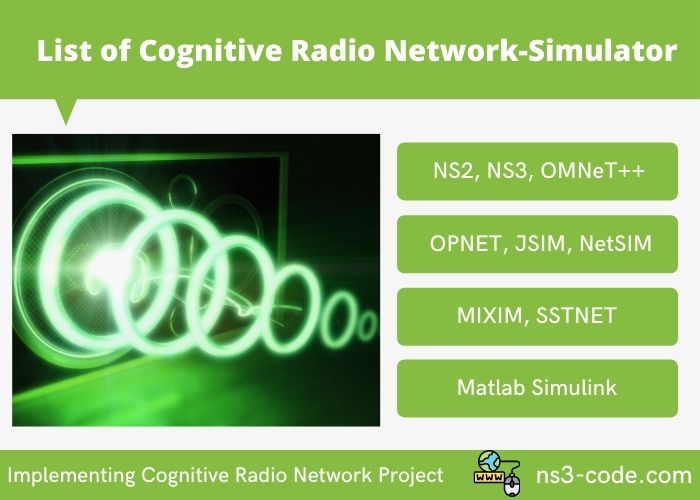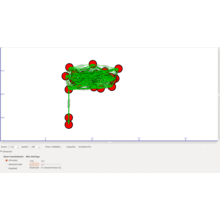Cognitive radio (CR) is a network that senses the environment for gathering information about the availability of the spectrum. Further, it analyzes the spectrum and efficiently allocates the spectrum to both primary and secondary users without disturbing the user’s QoS. As a matter of fact, most of the 5G sensors have CR capability for fast data delivery. In order to build and simulate CR models many number of cognitive radio network simulator are available.
CRN Transceiver Architecture
In the general architecture of CRN, there are four major layers such as physical, MAC, network, and applications. Bypassing all these layers, the data are transmitted from source to destination. Also, we can perform data analysis, route selection, and resource allocation through machine learning approaches. Let’s see the layers in the secondary user transceiver with their purpose:
Secondary User Transceiver
- Physical Layer
- MAC Layer
- Control the spectrum sensing, analysis, and decision making
- Network Layer
- Perform reconfiguration and routing process to improve QoS
- Application Layer
- Manage the required APIs and software
Now, we can see the core functionalities of the Cognitive Radio Network Simulator. Generally, when you are choosing the CRN simulator for your project execution, you should note down whether the following key operations are supported in your handpicked tool.
What are the functions of the Cognitive Radio Network Simulator?
- Simple to allocate the resource to the unlicensed secondary users without creating interference to primary users
- Create the global level configuration by taking mutual decisions over optimal spectrum allocation
- Ensure the quality of service control and management
- Easy to classify the occupied and unoccupied spectrum for further spectrum access
- Since the real-world cognitive environs to obtain spectrum waves that comprise noise, primary and secondary users action
- From the collected spectrum waves, we can extract the essential characteristics
- Enable to perform learning approaches to predict the accessible spectrums and choose the optimal one
- Effective routing mechanisms to distribute the spectrum and perform network processes
- Enable to create of various real-time and non-real-time applications
We Hope, now you are clear with the fundamental information of cognitive radio networks with their simulator’s characteristics. Our research team has a habit of frequently updating their skills to present you latest research CRN Ideas. From our recent study, we have identified the following issues as research gaps in CRN.

Research Gaps in CRN Paradigms
- Overlay
- Feedback Overhead
- RF Deficiencies
- Multi-Channel Uncertainty
- Interweave
- Feature and Time Mismatch
- Uncertainty in Noise
- Radio Transceiver Imperfection
- Noise Variation and Correlation
- Uncertainty in Signal Concentration
- Underlay
- Direction Of Arrival (DoA) Uncertainty
- Signal Uncertainty and Recovery
- Transceiver Hardware Defectiveness
- Noise Ambiguity
- Improbability in Channel and Interference
From the above, we can grasp the knowledge of recent CRN research challenges. Now, we can see the protocols that used in the CRN research topic development. For each layer of CRN, a different set of protocols are available. For your ease, we have classified the protocols based on the CRN layers. In addition, we have also given the information of data rate, channel volume, modulation, frequency range, etc.
CRN Protocols
- Application Layer
- Voice over IP (VoIP)
- Video and Email
- Constant Bit Rate (CBR)
- Hypertext Transfer Protocol (HTTP)
- File Transfer Protocol (FTP)
- Transport Layer
- User datagram protocol (UDP)
- Transmission control protocol (TCP)
- New Reno
- Old Tahoe
- BIC and CUBIC
- Reno
- Tahoe
- Network Layer
- Internet Protocol version 4 (IPv4)
- Data Link Layer
- Various Time Events / Stamps: Timer14, Timer31, Timer7, Timer16, Timer29 and Timer8 (Waiting Timers)
- Message configuration – Modification of Response Retries and DSX_Request metrics
- Protocol – IEEE802.22-2011 MAC
- Mode of Sensing
- Duplex Scheme – Time Division Duplex (TDD)
- Channel Improvisation Metrics:
- Sensing Time
- Channel Switching Time
- Sensing Interval
- Probability of False Alarm
- Candidate Wait Time for Channel Switching
- Number of Tradeoff
- Channel Check and Detection Time
- Channel Unused Time
- Channel Refresh Time (Candidate and Backup)
- Physical Layer
- Bit Rates
- High: 22.69 Mbps
- Code Rate 5:6
- Spectral Efficiency 3.78
- 64QAM
- High: 22.69 Mbps
- Low: 4.54 Mbps
- Code rate 1:2
- Spectral Efficiency 0.76
- QPSK
- TTG – 210 µs
- Transmitter Power ranges from 1 and 5000 mW
- Protocol: IEEE802.22-2011 MAC/CC
- Upload and Download Ratio – 1:2, 1:4, 1:1, 1:3
- Highest Frequency – 862MHz
- Lowest Frequency – 54MHz
- Modulation Types
- Quadrature Amplitude Modulation (16, 64)
- Quadrature Phase Shift Keying (QPSK)
- Channel Code Rate – 2/3, 1/2, 5/6, 3/4
- Channel Capacity – 6,7,8 MHz
- Back off start – 0
- Back off the end – 15
- Inter-Frame Quiet Period (IFQP) Protocol Cycle Length – between 0 to 15
- Upstream Channel – 2 sec (Waiting time for a change of signal)
- Bit Rates
Now, we can see the widely used Open-Source Cognitive Radio Network Simulators. These simulators offer special modules for processing CRN operations. For your information, we have listed that too.
Popular Open Source Network Simulators
- Ns-3
- Cognitive Radio Extension for NS3 (CRE-NS3)
- Cognitive Radio Cognitive Network (CRCN)
- OMNet++
- Cr Simulator
- MiXiM
- Ns-2
- Cognitive Radio Networks (CogNS)
- Cognitive Radio Ad Hoc Networks (CRAHN)
- Cognitive Radio Cognitive Network (CRCN)
Further, we have listed some important features of the simulators. These features will vary from the simulator to the simulator.
Features
- Maximum PUON Time
- Documentation Help
- Support large-scale CRN
- Interfaces per Cognitive Radio Node
- Allow Large Volume of PUs and SUs
- Graphical User Interface (GUI) Support
- Multiple Channel-Multiple Radio – (MC-MR)
- Include CR Mobility Models and MAC Protocols
- Facilitate to import or modify present entity characteristics
So far, we have discussed open-source simulators. Now, we can other CRN system simulation tools. These simulators support you to design and simulate any complex CRN structure and functions.
Top List of Cognitive Radio Network-Simulator
- MATLAB
- Omnet++
- NS3
- SSTNET
- NetSim
- MIXIM
- Opnet
- NS2 Simulation [CogNS, Crahn]
- JSIM
From the above-specified network simulation tool, we can take the NS2 simulator as an example. Through this, we can evaluate the network behavior before the direct deployment. For instance: we can assess the dynamic resource assignment, power control, etc. Overall, we can make real network topology, and also it supports several protocols and metrics to allow transmission among various layers.
CRE-NS3
In particular, cognitive radio extension for ns3 is the supportive module specially designed to perform CRN operations such as spectrum access decision making, capturing spectrum gaps, spectrum sharing, and more. For illustrative purposes, here we have given the specification of the NS3 Cognitive Radio Network Simulator. This will show you how the CRN processes are performed (NS3 Documentation) and developed.
System Requirements
- Software: NS-3 (Version 3.17)
- Operating System: Windows, Mac OS x, Linux
- Specification
- Spectrum Sensing / DB Query
- It is the submodule of spectrum manager to process the sensing operations
- Spectrum Manager
- In the simulator, it is the main module that offers the cognitive radio software / APIs to the network layer
- Spectrum Sharing
- This module ensures that the unused spectrum is allocated to the cognitive nodes using the respective protocol. For instance: IEEE 802.11
- Spectrum Decision
- This module assists to decide like to whom the resource to be allocated
- Spectrum Mobility
- This module helps to perform handoff between channels
- Spectrum Sensing / DB Query
In addition, this CRE- NS3 Simulator has four primary components as Global Database, Application Programming Interface (API), Data Repository, and RF Spectrum Manager. These key components play a major role in developing CRN projects.
Next, we can see about the Cognitive Radio Sensor Networks (CRSN) supportive simulation tool namely, CRSN. Here, we have given you the different layers of the CRSN tool and followed by their main source files that are used in the project development for key CRN operations.
CRSN Simulator
- Data Sharing Layer
- Wireless CR-Sensor MAC Layer
- Wireless CR-Physical Layer
- Wireless CR-Sensor Network Layer
- Support Multi-Channel and Energy Model
- Assessment of Spectrum Usage
- Enable Primary Radio Actions
- Establish interaction through Control Channel
Major files of CRSN
- Cognitive Radio Sensor Networks (CRSN) Capability
- Multi-Channels, Primary Radio, and Energy Model
- Node.h
- Maccon.h
- Node.cc
- Maccon.cc
- For instance: On using these files, we can set the timers to activate the PR model and assess the channel consumption
- Multi-hop Message Distribution
- Cmu-trace.cc
- Aodv.cc
- Aodv_packet.h
- Cmu-trace.h
- Aodv.h
Last but not least, now we can see about the CRN System performance evaluation metrics. These metrics are used to assess the current network performance and efficiency of the developed system for further betterment.
CRN Output Performance Metrics
- Throughput (for whole Application and separate Link)
- CPE Parameters
- Network Parameters
- Channel Parameters
- Routers Parameters
- IP Parameters
- Dynamic Parameters `
- Incumbent Parameters
- Base Station (BS) Parameters
- UDP / TCP Protocol Parameters
Further, if you need more information about this field then contact us. Certainly, we help you in both the research and development phases of Cognitive Radio Network Simulator Projects.

 Click Here to watch our latest output video using NS3 simulator
Click Here to watch our latest output video using NS3 simulator  Click Here to watch our latest projects screenshots using NS3 simulator
Click Here to watch our latest projects screenshots using NS3 simulator